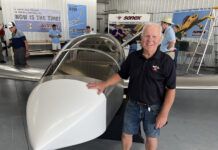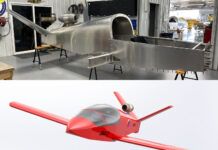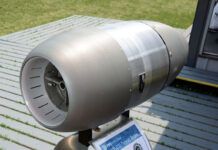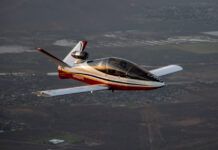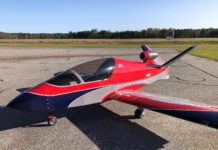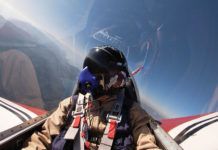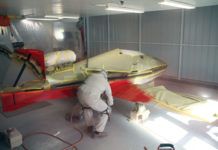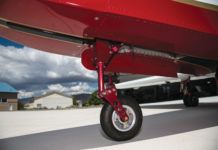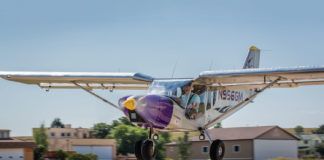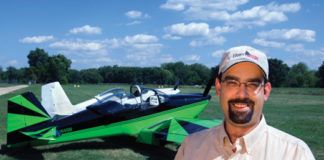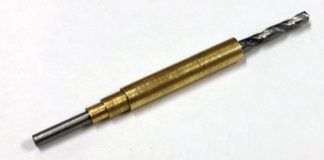Whether our airplane-building budget supports a Pietenpol or an RV-8, most folks who have the gumption and the skill to build and fly their own airplanes were not born sucking on a silver spoon. Most of us in the homebuilt world grew up reading about BD-5s or Teenie Twos in Popular Science and Mechanics Illustrated. And most of us have reached beyond our grasp to build and/or fly airplanes far more sophisticated than we ever dreamed possible when we were parsing the words in those Readers Digest-sized science magazines so many years ago. It’s the nature of progress and aspiration.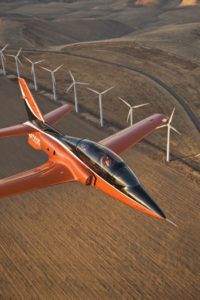
Without that ability to imagine, we would never build or buy an airplane we assembled or put together by others in a garage, much less fly it. So let’s relax our cynical side that says, “I could never afford to build nor have the skills to fly a ViperJet” and do some of that youthful dreaming that served us so well and has brought us so far. What could it hurt? Believe me, it’s fun!
Recalling Reno
I first saw the ViperJet at the Reno Air Races in 2006. I walked by and marveled at the little airplane with a General Electric J85 engine. The J85 is the military version of the CJ-610, the engine that powered the -20 series Learjets and the Jet Commander as well as some other 1960s vintage business jets. In the great tradition of the Pontiac GTO or Mustang Cobra, the J85 is powerful, loud and sucks down Jet A like there’s no tomorrow.
I flew the Jet Commander years ago, and while I fell in love with its instant power response and bulletproof dependability, I learned early that flying pure jet engines was an exercise in preflight planning and judicious fuel management. I flew with a pilot named Keith, who grew up flying pure jet engines, and he taught me the rules. Rule No. 1 was you are out of gas and on fire at brake release, and the situation deteriorates from there. Rule No. 2 was never, ever let ATC fly your airplane. Unnecessary vectoring or an early descent meant landing with the low-fuel lights flashing, or worse.
When I saw the compact ViperJet at Reno, I knew it was an animal. I knew, too, that it was not for the faint of heart, and I wanted desperately to fly that little rocket ship. But as far as building or buying one, that was a dream that involved lottery tickets, and I don’t buy lottery tickets. That didn’t stop me from dreaming about flying the ViperJet.
When the call came, “Would you be willing to go to Pasco, Washington, and fly the ViperJet?” it was a short conversation. I packed my hard hat and a Nomex flight suit. I planned to fly a prototype with parachutes and utilitarian cockpit—much like the airplane KITPLANES® reported on in March 2006. Arriving there I found an air-conditioned airplane with glove leather interior and rosewood inlaid circuit-breaker panels. When demo-pilot Greg Bennett appeared in Levi’s and a ball cap to fly with me, I realized the airplane was farther down the development path than I expected.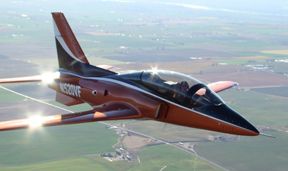
Continued Development
The ViperJet project has been in the making for a while. Brothers Scott and Dan Hanchette started the company in 1995 with the plan to build an airplane called the ViperFan, which was to be a piston-powered, propeller-driven pusher. Early in the program the brothers saw the difficulty of producing the drive train for a pusher prop. “If we had a problem with the drive system, we fail,” Scott said.
The brothers were involved in buying and selling French Fouga Magisters. They called an associate, and two weeks later a Turbo Mecca jet, the same engine that powers the French jet trainer, arrived. Thirty days later they were taxiing.
The first flight was in 1999. They flew for a year and then switched to a T-58 turboshaft from a CH-46 helicopter. The drive portion of the engine was replaced by a tailpipe, converting the shaft engine into a jet with 700 pounds of thrust. That engine was underpowered, and when the military gave the firefighters first chance at the surplus engines, the supply dried up and another engine choice was needed.
Fortuitously, a Lear 23 landed at Pasco one day. The brothers measured the engine and realized it would fit, and it would provide more than enough thrust. At that point they had sold five kits. “We upgraded those kits to the MKII configuration (with a carbon-fiber wing) at no charge,” Scott said. The first flight of the MKII was on June 12, 2005.
Winging It
The MKII airplane has 25° of wing sweep in the leading edge and 6° in the trailing edge, but the airplane handles and flies like a straight-wing airplane. All of the controls are actuated by pushrods except the rudder, which has cables. The nosewheel casters, and the gear, flaps and speed brakes are electro/hydraulic.
Clever features are incorporated throughout. Some of the most ingenious are the electromagnetic landing-gear-up locks. The down-locks are integral in the actuators, using a ball/collar system that snaps down by either hydraulic pressure, carbon dioxide blow-down or gravity, and are released by the hydraulic pressure on retraction.
The cockpit looks more like a luxury car than a hot-rod jet—a big change from the previous iteration of this aircraft. The canopy is rear hinged and opens manually on a gas strut, pulled down by a convenient and simple hanging strap. The canopy hinge seems strong enough to handle the strongest winds; locks are robust and designed to hold the 5.5 psi cabin differential that will be in subsequent airplanes. The limited amount of panel space in the front cockpit is used efficiently by a pair of Op Technologies integrated EFIS screens that include navigation, com and engine instrumentation. The rear cockpit has a third EFIS panel integrated with the front cockpit.
The airplane always had a tail stand in place, and the crew at ViperJet were careful to tend the nose when it did not. Without the tail stand, and with no passengers in the airplane, the weight on the nosewheel was minimal. A step slides into a receptacle on the left side for boarding, and the front cockpit is comfortable. I was relegated to the rear seat, which was also comfortable, with good head and legroom, but the canopy longerons were tight just above my elbows.
The battery is adequate for starting the turbo-jet, but the J85 and the CJ-610 are single-shaft engines, and the starter must spin the entire rotating element; using ground power ensures cooler starts and lower engine maintenance costs. Starting is simple: Turn on the boost pump, the igniter and the starter. When the engine reaches 10% rpm, turn on the fuel and monitor the Internal Turbine Temp (ITT) for a hot start. When the engine is idling, the starter becomes the generator, the ignition is turned off, and the fire is self sustaining.
Gulp…
Even at idle power the J85 burns 75 gallons per hour. That is not a misprint. The airplane holds only 300 gallons in three tanks, so once the engine is running, getting airborne becomes a priority.
Little additional thrust is needed for taxi, and once the airplane is moving it rolls easily. The rudder seems effective at low speeds, and little braking is needed to steer. There is no need to run up a jet, and the before takeoff checklist is short.
Cleared for takeoff, we took the runway and the fun was about to begin. I was a passenger for the takeoff, but it was straightforward and fast. To say the acceleration was brisk is an understatement. A boot in the butt is a better assessment. The airplane sits nose low, and it appeared to require a tug to unstick the nose at around 90 knots. By the time the nose was up, we were airborne and the gear was quickly retracted to avoid overspeeding the gear. The nose continued to rise, the airspeed continued to accelerate, and in moments we were at 250 KIAS at a ridiculous deck angle with the VSI pegged. In moments we leveled at 10,500 feet, accelerating in spite of a healthy power reduction.
I looked at the fuel flow on takeoff, but it was off scale. Leveling at 10,500, we did a speed run. Burning 240 gph—again, not a misprint—the airplane was accelerating briskly. The flight-test program had not exceeded 325 KIAS, which is 420 KTAS, and we reached that quickly. We took off with 200 gallons of fuel on board, so our time flying at that power setting was limited. Pulling the power back to a miserly 120 gph yielded a more reasonable 230 KIAS, which equated to 300 KTAS.
Nature of the Pure Jet
These numbers seem ridiculous, and they are. Pure jet airplanes are intended to climb quickly to their maximum operating altitude, and they do best when they can remain there until an idle thrust descent takes them to their destination. With the pressurization functioning, the airplane would climb quickly to FL270 or FL280, where the 5.5 psi cabin differential would yield a 10,500 foot cabin pressure.
At those flight levels the ViperJet folks say the airplane will true 320 KTAS, burning 90 gph. The J85 or its CJ-610 cousin would be much happier at FL390 or even FL410, but reduced vertical separation minimums (RVSM) require strict certification and autopilot requirements, making FL280 the practical ceiling of the airplane.
Once it was clear that the airplane would go really fast it was time to find out if the airplane would go slow. I took the stick for some air work. The stick forces were comfortable in pitch and slightly heavy in roll. The rudder forces are immaterial because without any torque there is little need for rudder. The vertical seems large enough that the airplane is stable in yaw.
Steep turns are not difficult, but the airplane changes altitude so easily that flying to check ride standards requires close attention. Some slick, fast airplanes have a dark underbelly that appears at the bottom end of the airspeed tape. I pulled the airplane to flight idle. Airplanes without propellers don’t slow down. The only way to get the airplane near its stall speed was to pull the thumb switch on the power lever aft. This deployed the speed brake with a significant pitch down and rumble.
Clean, the airplane started a noticeable buffet just below 100 KIAS and broke straight ahead at 96 KIAS. Easing the back pressure got the airplane flying again quickly, and with a slight bump on the power lever the airplane accelerated. Extending the flaps lowered the buffet to 90 and the stall to just under 85. At 85, I held full aft on the stick and the nose dropped, the airplane hooked up, the nose came up again, stalled and dropped again. Just like a Cherokee 140, which would qualify it for impeccable manners status (for a high-performance jet). All this occurred with no roll off on a wing or any tendency toward a deep stall. Add power, and the airplane flew out of the stall instantly. One of our tasks was a photo session, so we joined up with a Seneca at 140 KIAS; the airplane was solid and flew formation easily even in the afternoon bumps.
Another one of Keith’s rules was the less time the engine is run, the less fuel you burn. The ViperJet has an automatic system that transfers fuel from the wing tanks to the fuselage tank that feeds the engine. When the wings are dry, that leaves 15 gallons to burn before the bingo fuel light comes on, signaling the end of the party. We turned to the airport and pushed the nose down. Even at low power in descent, it’s easy to bump the 250 KIAS limit below 10,000 feet.
Sliding the thumb switch back on the throttle slows the airplane to a comfortable 140 KIAS on downwind. The speed brake was deployed, and we used the approach flaps. Back to 120 KIAS on base, full flaps on final and then slow to cross the threshold at 105 KIAS. Again, I was a passenger for the landing, but it was clear that it provided no unreasonable challenge, even in the crosswind.
Retract the speed brakes, flaps and lean on the throttle, and the airplane leaps into the air. In seconds, it’s at pattern altitude, on downwind, at 140 KIAS. With the power back and the gear, flaps and speed brakes extended, the airplane again becomes docile and flies easily around to another landing.
Without reverse and with significant residual thrust, the only way to stop is the brakes. Prop jockeys, especially turbo-prop jockeys spoiled by reverse, will be uncomfortable leaning so heavily on the brakes, but the airplane has large disk brakes built specifically for the airplane by ViperJet. We burned lots of fuel and lots of adrenaline in our 45-minute flight, but what a ride!
Where We Go from Here
ViperJet has sold 20 MKII kits, a second airplane has flown, and others are close. Zero Gravity Builders Studio, a builders assistance shop owned and operated by Rob Huntington, is adjacent to the ViperJet facility and has several airplanes in various stages of completion.
Even with decreasing fuel prices, the market for an airplane that burns over $5 per minute at idle and four times that at full power is small. The insatiable thirst of the pure jet engine outweighs the low acquisition price. That leads to ViperJet’s next project, which is in the tooling phase now: the FanJet.
The FanJet is a slightly larger version of the ViperJet that uses a Pratt & Whitney JT-15D. This is the engine that powers the early Cessna Citations and Beechcraft Beechjet. The specific fuel consumption of the fan jet engine is nearly half that of the pure jet, and the engine is able to operate more efficiently at lower altitudes where homebuilt jets will most likely be forced to operate because of RVSM. The FanJet will share many parts and systems with the ViperJet, making the development process much faster than the 13 years the company has been working on the ViperJet.
The Hanchette brothers have no vision of certifying the ViperJet or the FanJet and selling hundreds. Their business model is to focus on low-volume production of the ultimate kit plane with incredible performance. The FanJet will also be designed to accommodate ejection seats should some small country choose the FanJet for a military trainer.
ViperJet has suspended sales of the MKII kit in anticipation of the FanJet. A flying ViperJet, fully equipped, will end up north of $1 million, and with a more expensive engine the Fanjet will cost more. Those price points will leave most of us dreaming, but there is a market for a high-performance airplane with capability as a cross-country cruiser and aerobatic fighter-like handling and performance—even if it’s a small one.
Who Wants to Be a Millionaire?
Most of us know the answer to the question, “Can I afford it?” A more interesting question might be, “Could I fly it?” That’s a different query altogether, and the answer might not be as clear.
From what I observed and the flying I did, I can report the Viper is easy to fly. Most jets are easy to fly, but high-performance airplanes have lower margins for error. An extra 10 knots on final is not an issue on most runways in a Kitfox or a GlaStar, but 10 knots extra in a jet without reverse can mean an excursion off the end. The ViperJet has excellent stall manners, and while we didn’t go poking in the corners looking for snakes, none was evident. This is an airplane that could be flown by a current competent pilot with proper training.
Flying IMC would require a functioning autopilot, thorough preflight planning and a high level of currency, but so would a TBM, Cessna, Mustang or a turbine Lancair. Whether it is the airspeed control on final or the fuel planning on a cross country, high-performance airplanes require a greater level of discipline because even small errors could have large consequences. The biggest difference between the ViperJet and those other airplanes is managing fuel for the ever thirsty pure jet engine. The FanJet will go some ways to resolving that problem.
That leaves only one more difficulty: I still can’t afford one. But 40 years after I lusted for the BD-5 in Popular Science, I can still dream. After all, my mother-in-law gives me a lottery ticket every year for Christmas.


